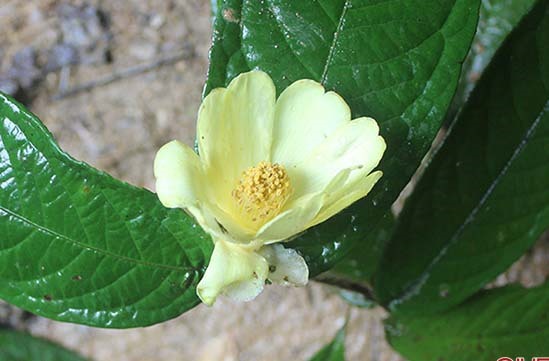Two new plant species discovered in Viet Nam protected area

Camellia vuquangensis found in Vũ Quang National Park
Photo by Viet Nam News
Two new species of tea plants were recently discovered by scientists and academicians of Da Lat University in Vũ Quang National Park in the province of Hà Tĩnh, Viet Nam. The said species are Camellia vuquangensis, a 3 to 4 meter high shrub with narrow light purple leaves; and Camellia hatinhensis, a 4 to 6 meter high shrub with hairy shoots and oval leaves. Both species bears yellow flowers.
“The discovery of two new species of tea plants in Vũ Quang National Park in the province of Hà Tĩnh, Viet Nam joins the multitude of reasons why the establishment of protected areas (PAs) is important. Being situated in a protected area ensures the protection of these new species from overexploitation and unsustainable use,” said the ASEAN Centre for Biodiversity (ACB) Executive Director, Dr. Theresa Mundita S. Lim. “The number of species awaiting discovery far outweighs those that have been studied. Millions of plants and animals have yet to be studied and may hold tremendous potential as sources of food, medicine, and other benefits. The Centre would like to congratulate Viet Nam on this very good news,” she added.
Strengthening PA management for species protection
Dr. Lim emphasized the value of strengthening protected areas in the region and cited the outcomes of the recently held 22nd Meeting of the Subsidiary Body on Scientific, Technical, and Technological Advice (SBSTTA 22) of the Convention on Biological Diversity (CBD) in Montreal, Canada which called for intensified management of protected areas.
This was also reflected in the ASEAN Member States’ (AMS) statement in SBSTTA 22 which highlighted how far the region has gone in the attainment of AICHI Biodiversity Target 11, which states that “by 2020 at least 17 percent of terrestrial and inland water, and 10 percent of coastal and marine areas, especially areas of particular importance for biodiversity and ecosystem services, are conserved through effectively and equitably managed, ecologically representative and well-connected systems of protected areas and other effective area-based conservation measures, and integrated into the wider landscapes and seascape.”
ACB, together with the AMS, is carrying out biodiversity conservation efforts in protected areas through its ASEAN Heritage Parks (AHP) programme. AHPs are selected protected areas in the ASEAN region which are known for their unique biodiversity and ecosystems, wilderness and outstanding values; they were given the highest recognition because of their importance as conservation areas.
The AHP programme of ACB strengthens protected areas in the region through capacity building activities for park managers and stakeholders in the form of various learning events, such as trainings and workshops. AHPs also receive technical assistance from the AHP Secretariat and its network of partners. Being an AHP also increases the park’s visibility as a prime ecotourism destination and model for effective protected area management. Participation of and collaboration among AHP stakeholders in the implementation of research and development programs and projects are also maximized and strengthened when a protected area is declared as an AHP. Presently, there are 40 declared AHPs, and this network of biologically-rich protected areas continue to increase through the collective efforts of the AMS.
The ACB was established in 2005 by the ASEAN Member States as a response to biodiversity loss in the region. The Centre supports and coordinates the implementation of activities in the ASEAN leading to the conservation and sustainable use of biological diversity, for the benefit of the region and the AMS.
